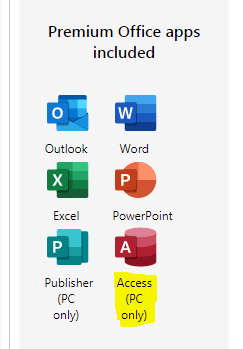

- #CAN YOU HAVE MICROSOFT ACCESS ON A MAC FOR MAC#
- #CAN YOU HAVE MICROSOFT ACCESS ON A MAC UPGRADE#
- #CAN YOU HAVE MICROSOFT ACCESS ON A MAC WINDOWS 10#
- #CAN YOU HAVE MICROSOFT ACCESS ON A MAC ANDROID#
- #CAN YOU HAVE MICROSOFT ACCESS ON A MAC LICENSE#
Once you have the remote desktop functionality ready on your Windows PC, you can start the installation process and configure RDP on your Mac.
#CAN YOU HAVE MICROSOFT ACCESS ON A MAC FOR MAC#
It’s also what you need to do to access Remote Desktop for Mac successfully.Īfter you have the Enable Remote Desktop option selected and the PC name noted, you’re ready to install the app on your Mac so that you can access those resources.
#CAN YOU HAVE MICROSOFT ACCESS ON A MAC ANDROID#
That means you can use the PC name through another Windows computer, an Android app, or an iOS mobile device. Once you follow these steps, your Windows PC is ready to accept remote connections from any device operating RDP. You might consider changing it to something more user-friendly if you don’t have a way to write it down. You’ll see a menu option called Enable Remote Desktop to select.

#CAN YOU HAVE MICROSOFT ACCESS ON A MAC UPGRADE#
Click on it to see what you have and upgrade if necessary. You’re looking for the Edition selection. Go to your Start menu, click on Settings, go to System, and choose the About option.
#CAN YOU HAVE MICROSOFT ACCESS ON A MAC WINDOWS 10#
#CAN YOU HAVE MICROSOFT ACCESS ON A MAC LICENSE#
To determine the Office subscription license type, open an Office app (such as PowerPoint), select the name of the app in the menu, and then About (app).įor more information, see Find details for other versions of Office. The license type will be listed below the Product ID. To determine the Office volume license type on a Mac, open an Office app (such as PowerPoint), select the name of the app in the menu, and then select About (app). In this example, the license channel is reflected as RETAIL or VOLUME. Type the following command to navigate to the Office folder:Ĭd c:\Program Files (x86)\Microsoft Office\Office15\Ĭd c:\Program Files\Microsoft Office\Office15\Īt the command prompt, type cscript ospp.vbs /dstatus, and then press Enter.

Follow the steps to find your license type and other details about your version of Office.

If you're using a Microsoft 365 product, see View Microsoft 365 licenses and services with PowerShell. To determine whether you have a retail edition or a volume license edition, use one of the following methods, depending on which version of Microsoft Office product you've installed.


 0 kommentar(er)
0 kommentar(er)
